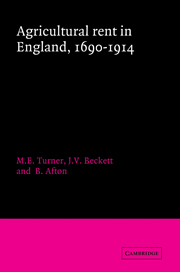Book contents
- Frontmatter
- Contents
- List of figures
- List of tables
- Preface
- Note on the text
- List of abbreviations
- Two examples of contemporary rent books
- Introduction
- 1 Agricultural rent in England
- 2 Contemporary views of rent in eighteenth and nineteenth-century England
- 3 The current state of knowledge
- 4 The determining parameters of a rent index
- 5 Constructing the rent index I: estate records
- 6 Constructing the rent index II: government inquiries
- 7 Constructing the rent index III: other studies
- 8 An English agricultural rent index, 1690–1914
- 9 Rent arrears and regional variations
- 10 The rent index and agricultural history I: the long term
- 11 The rent index and agricultural history II: the short term
- Conclusion
- Appendix 1 Sources of the rent index
- Appendix 2 Statistical summary
- Bibliography
- Index
9 - Rent arrears and regional variations
Published online by Cambridge University Press: 02 December 2009
- Frontmatter
- Contents
- List of figures
- List of tables
- Preface
- Note on the text
- List of abbreviations
- Two examples of contemporary rent books
- Introduction
- 1 Agricultural rent in England
- 2 Contemporary views of rent in eighteenth and nineteenth-century England
- 3 The current state of knowledge
- 4 The determining parameters of a rent index
- 5 Constructing the rent index I: estate records
- 6 Constructing the rent index II: government inquiries
- 7 Constructing the rent index III: other studies
- 8 An English agricultural rent index, 1690–1914
- 9 Rent arrears and regional variations
- 10 The rent index and agricultural history I: the long term
- 11 The rent index and agricultural history II: the short term
- Conclusion
- Appendix 1 Sources of the rent index
- Appendix 2 Statistical summary
- Bibliography
- Index
Summary
The rent index we have described in chapter 8 has provided us with national data over a period of more than two hundred years, and the tests that we have applied suggest that the findings are definitive within the parameters we established at the outset. Before we proceed in chapters 10 and 11 to examine the implications for agricultural and economic history more generally, the index offers us other data from which we can trace agricultural trends: in particular, in relation first to times of plenty and times of dearth; and second to regional variations in the long-term rental trends. We examine these questions in this chapter.
Integrating rent due and rent received
One of the major questions which we have had to address is the mismatch between those archives which reveal rents which were due, and those which reveal rents which were actually received. Where an archive gives both it is possible to construct two indexes which refer to the same geography and chronology, and which therefore share a common acreage. In these cases the observation for each year is a unique event because, as with our separate indexes for rents due and rents received, the sample of estates which are represented each year changes according to the random survival of the records. However, even though the schedules of rents due and rents received from common acreages may appear as a chronological patchwork, they do share one important parameter arising from the original research method employed. This was the desirability, which became a necessity, of having relatively long runs of records.
- Type
- Chapter
- Information
- Agricultural Rent in England, 1690–1914 , pp. 176 - 198Publisher: Cambridge University PressPrint publication year: 1997

